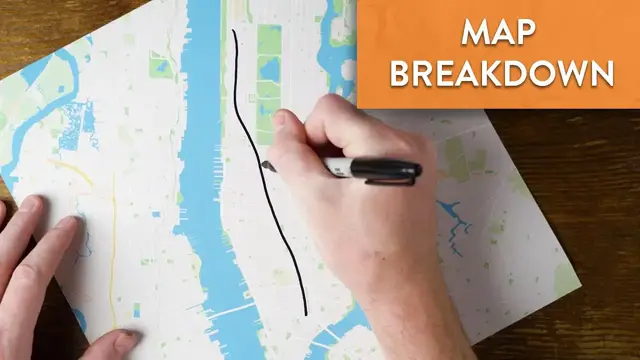Manhattan is one of the most intriguing cities in the world, but its street grid often confuses visitors. This short video lays out how the map of Manhattan NYC works, and will get you oriented to the key regions of the city, like lower Manhattan, the Upper East Side, or the Financial District.
Show More Show Less View Video Transcript
0:00
New York is big
0:02
It is home to some of the densest skyline on earth and has a population of over eight million people
0:09
It's broken into five sections or boroughs. Staten Island, Brooklyn, Queens, the Bronx, and Manhattan
0:18
This one right here is Manhattan and that is what we are going to focus on today
0:22
If you're going to visit New York for the first time, you're likely going to spend most of your time
0:26
on this island. New York, New York. The city's so nice they named it twice
0:31
Manhattan is the other name. It may just look like a simple grid of streets, but there is a bit more to it than that
0:35
So here's a quick breakdown to help you know your way around the most toured part of the United States
0:46
Okay, so starting very generally, you have uptown and you have downtown
0:50
This works kind of interchangeably as north and south. So if you're anywhere in the city and someone says uptown
0:55
it means this direction. And if anyone says downtown, it means this direction
1:00
The best way to orient yourself when you're looking at a map is by finding Central Park
1:04
which is right here, the center of the map. There's a lot of specific neighborhoods in the city
1:09
but what you need to know is that Central Park acts as a nice divider
1:13
So if you cut it off at the bottom and you cut it off at the top, that creates the Upper West Side and the Upper East Side
1:21
This section right here is generally Midtown. Wow, I spelled that wrong
1:27
Midtown. And anything down here is more the Financial District. And then above the park is Harlem
1:37
This goes further north, and there's really cool history up here, but most of the sites that you're wanting to see
1:42
like Times Square and where the Twin Towers were that all in this area here so that what we gonna focus on The Financial District is you guessed it the Financial Hub This is where Wall Street and so many tall buildings are including the World Trade Center and the Twin Tower Memorial
1:57
Midtown still has a ton of offices, but has the Theater District, where most of the Broadway plays are
2:03
It has Times Square, the Empire State Building, the Rockefeller Center, and Grand Central Station
2:09
The Upper East and Upper West sides both become much more residential
2:13
but this is where the Metropolitan Museum of Art, the Guggenheim, and the Museum of Natural History are
2:19
Harlem becomes even more residential, but does have some really cool historical spots
2:23
So the further uptown you get, the more residential it becomes. On the west side of the island, you have the Hudson River
2:31
On the east side of the island, you have the East River. And the avenues run uptown and downtown
2:37
and divide the city east to west. And these roads are much wider than most of the streets
2:41
which run in the other direction. But we'll talk about those in a second. First Avenue starts on the side of the East River
2:53
and then they work their way up numerically to 12th Avenue. Although they have alternate names you'll hear
2:58
like Columbus Avenue, West End Avenue, and 4th is called Park Avenue
3:04
which you might have heard of because it's a fancy part of town. Lexington and Madison Avenues are two additional avenues
3:09
that break the blocks up further on the Upper East Side. When it comes to avenues, here's the main thing to know
3:15
This one right here that borders the East Side of Central Park is Fifth Avenue
3:23
Fifth Avenue has a lot of nice shopping and is considered the center point for the city
3:28
Any street west of it becomes its number and West Street. Any street east of it becomes its number and East Street
3:34
There a little avenue here called York Avenue that doesn last for long And that leads us down to this portion of the city right here Because they weren gonna start doing negative avenues they named these Avenue A Avenue B Avenue C and Avenue D
3:49
Because of that, this area is called Alphabet City and is often referred to as the Lower East Side
3:57
Now, let's talk about streets. Streets are the ones that work their way laterally
4:01
up the island this way. They start right here with Houston Street
4:06
So Houston kind of works as First Street and work their way north from there
4:14
I know it looks like it's pronounced Houston, but I promise it's Houston
4:17
The neighborhood just south of this is referred to as Soho, south of Houston
4:22
and the neighborhood just north of this is referred to as NoHo, north of Houston
4:26
The main thing to know about streets is that most of them are one ways. Because of this, they are much more narrow than the avenues
4:32
And one thing to remember is that odd-numbered streets flow to the west and even-numbered streets flow to the east
4:37
You can remember this because even, east, both E's. For example, this is 38th Street
4:43
Because it is an even street number, it runs to the east. And 39th Street here runs to the west
4:49
You can see the arrows signifying this here on Google Maps. Remember this because it is helpful to orient yourself when you come out of the subway
4:56
There are also several exceptions to this. 15, actually. And they're the wider streets that are two-way streets
5:03
And most of these are the busy ones that the subway stops on. This idea of exceptions actually leads me to my last point
5:17
Okay, bear with me for a quick history lesson. The first part of Manhattan to be settled was this area down here, which is now the financial district
5:24
And in 1811 they decided on a rule that would make the entire city a grid system So all the way up to Houston Street was prior to 1811 before this rule was in place
5:36
So all of these streets right here get pretty messy. This grid system makes it really easy to get around today
5:42
And it devises a cool way for them to build buildings like this one, the Dakota, which back in the day was just out in the middle of nowhere
5:48
but now today perfectly fits in with the rest of the city
5:52
But even with this rule, there's one major exception, and that's Broadway
6:00
Broadway completely ignores the grid system and runs diagonally through the city, creating these weird angled intersections as it passes through the avenues
6:07
The most notable of these have parks that are often referred to as squares
6:12
So right here you have Columbus Circle, which is kind of funny that it's the only one that's a circle, but there's a massive roundabout here
6:18
and then you go down to Times Square, Herald Square, and Madison Square
6:26
In addition to Times Square, one of the most notable things that this angle creates
6:30
is buildings like the Flatiron. Another exception is that the subway map
6:37
is not geographically accurate, so do not try to use it to get around above ground
6:42
Look at the difference between the two of them. Just look at the shape of Central Park in each of these
6:48
There are a million things to know about New York City, but this little bit will take you a long way
6:56
I hope you guys enjoyed this video. If this was helpful and you like these map breakdowns
7:01
we do it frequently in our full courses at brighttrip.com. We have places like Tokyo
7:07
Cape Town, London, Iceland, and we're going to be posting a lot more on this channel
7:12
So if you like this, please subscribe and we'll catch you next time
#Urban & Hip-Hop
#Maps
#Tourist Destinations
#Tourist Destinations
#Regional Parks & Gardens
#Theme Parks



